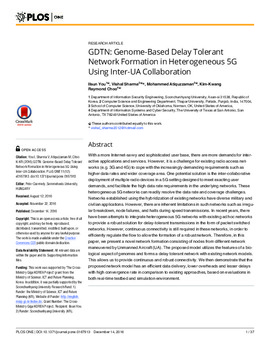| dc.contributor.author | Ilsun You | |
| dc.contributor.author | Vishal Sharma | |
| dc.contributor.author | Mohammed Atiquzzaman | |
| dc.contributor.author | Kim-Kwang Raymond Choo | |
| dc.date.accessioned | 2017-03-05T23:41:00Z | |
| dc.date.available | 2017-03-05T23:41:00Z | |
| dc.date.issued | 2016-12-14 | |
| dc.identifier.citation | You I, Sharma V, Atiquzzaman M, Choo K-KR (2016) GDTN: Genome-Based Delay Tolerant Network Formation in Heterogeneous 5G Using Inter-UA Collaboration. PLoS ONE 11(12): e0167913. doi:10.1371/journal.pone.0167913 | en_US |
| dc.identifier.uri | https://hdl.handle.net/11244/49298 | |
| dc.description | This work was supported by ‘The Cross-Ministry Giga KOREA Project’ grant from the Ministry of Science, ICT and Future Planning, Korea. Also, it was in part supported by the Soonchunhyang University Research Fund. | en_US |
| dc.description | | en_US |
| dc.description.abstract | With a more Internet-savvy and sophisticated user base, there are more demands for interactive applications and services. However, it is a challenge for existing radio access networks (e.g. 3G and 4G) to cope with the increasingly demanding requirements such as higher data rates and wider coverage area. One potential solution is the inter-collaborative deployment of multiple radio devices in a 5G setting designed to meet exacting user demands, and facilitate the high data rate requirements in the underlying networks. These heterogeneous 5G networks can readily resolve the data rate and coverage challenges. Networks established using the hybridization of existing networks have diverse military and civilian applications. However, there are inherent limitations in such networks such as irregular breakdown, node failures, and halts during speed transmissions. In recent years, there have been attempts to integrate heterogeneous 5G networks with existing ad hoc networks to provide a robust solution for delay-tolerant transmissions in the form of packet switched networks. However, continuous connectivity is still required in these networks, in order to efficiently regulate the flow to allow the formation of a robust network. Therefore, in this paper, we present a novel network formation consisting of nodes from different network maneuvered by Unmanned Aircraft (UA). The proposed model utilizes the features of a biological aspect of genomes and forms a delay tolerant network with existing network models. This allows us to provide continuous and robust connectivity. We then demonstrate that the proposed network model has an efficient data delivery, lower overheads and lesser delays with high convergence rate in comparison to existing approaches, based on evaluations in both real-time testbed and simulation environment. | en_US |
| dc.language.iso | en_US | en_US |
| dc.publisher | PLos One | |
| dc.relation.ispartofseries | PLoS ONE 11(12): e0167913 | |
| dc.relation.uri | http://www.plosone.org/article/info%3Adoi%2F10.1371%2Fjournal.pone.0167913 | |
| dc.rights | Attribution 3.0 United States | |
| dc.rights.uri | https://creativecommons.org/licenses/by/3.0/us/ | |
| dc.subject | Genetic networks,Network analysis,Chromosomes,Chromosome mapping,Simulation and modeling,Confidence intervals,Gene mapping,Flow rate | en_US |
| dc.title | GDTN: Genome-Based Delay Tolerant Network Formation in Heterogeneous 5G Using Inter-UA Collaboration | en_US |
| dc.type | Research Article | en_US |
| dc.description.peerreview | Yes | en_US |
| dc.description.peerreviewnotes | http://www.plosone.org/static/editorial#peer | en_US |
| dc.identifier.doi | 10.1371/journal.pone.0167913 | en_US |
| dc.rights.requestable | false | en_US |

